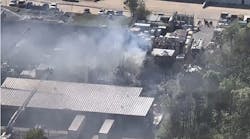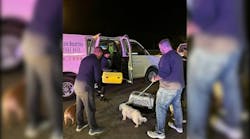The portable radio is the single most important device for public safety voice communications. Presently, there are more portable radios in the fire service than ever before. This increase in radio purchases nationwide is largely due to the FIRE Act Grant and Department of Homeland Security (DHS) public safety communications grants that followed the horrendous attacks of 9/11. Grants like the Public Safety Interoperability Communications (PSIC) grant injected billions of dollars for operable and interoperable radios.
The fact that there are more radios on the fireground presents some new challenges for incident commanders and firefighters that must be addressed to insure the safe and effective use of these radios. With the exception of large metropolitan cities, portable radios were only assigned to chief officers and company officers. In many localities, even that level of radio assignments was considered a luxury.
Today, radios are being assigned more frequently to every on-scene firefighter. As you can imagine or have already experienced, more radios increase the complexity of fireground communications. Whether it is the shear number of voice communications or the echoes from nearby radios, there is much more to communications than ever before.
Looking back, radios were also much simpler in their design and functionality. Radios had one or two channels; today the radios may have several hundred channels. Years ago, radios were only simplex and were analog; today the radios may be digital and/or operate on a trunked radio system. All of these changes and enhancements send a clear signal that much more training is required to use the radios effectively and safely.
The fire service also faces extreme environments which are generally unique to other public safety disciplines. Firefighters must enter extreme heat, zero visibility while searching for victims or trying to locate and extinguish the fire. The firefighter also works in challenging high noise environments such as power saws, apparatus engines, and PASS devices. Adding to these already difficult settings, the firefighter must operate the radio while wearing self-contained breathing apparatus (SCBA) and manipulate the radio controls with large bulky gloves in total darkness. All things considered, this sounds like (and could be) a recipe for disaster; especially if there is insufficient training with the very communications device that may be the only link to command or help should the firefighter become trapped and/or injured.
Here are a few questions to ponder:
- When members of your department start their service (volunteer or career) how much radio training do they receive?
- How well do you know how to use the radio that you use now?
- How much Mayday training do you conduct using radios?
- Do you have a Mayday radio procedure?
- How much do you know about the capabilities available to your radio?
- How well do you train/enforce proper radio discipline?
- Do you have an interoperability plan and exercise it?
If my hunch is correct and from what I have heard from a number of fire chiefs, there are a number of these questions that you answered uncomfortably. Unfortunately there are very limited recommendations when it comes to portable radio training.
Recognizing all of this, I believe that is imperative to promote the International Association of Fire Chiefs' (IAFC) Best Practices for Portable Radios PowerPoint presentation published in June 2008. I have abbreviated the best practices to focus on field user considerations, the full presentation can be found on the IAFC website.
Section 1: Field User Considerations for Portable Radio Use
Recommendation: Use the radio for the initial distress call before manual activation of the PASS in a Mayday situation when practical. PASS devices create a great deal of background noise very close to the radio microphone so transmitting on the radio before activating a PASS optimizes the probability that a voice message can be transmitted successfully.
Background: Providing a voice message imparts more information than activating the PASS device. Providing a clear radio report maximizes the probability of a successful resolution to the problem. Recommended sequence:
- Transmit a voice message
- Activate the PASS
Recommendation: Ensure that the microphone is placed one to two inches from the mouth or SCBA voice port with the microphone positioned directly in front of the audio source.
Background:The microphones in portable radios and accessories are optimized by the manufacturers to be one to two inches from the audio source when in use.
- Microphone performance is maximized when the audio is coming directly into the microphone and not entering the microphone from the side or back.
- Users should refer to the manufacturer manufacturer's documentation for the icrophone ports location on their specific SCBA.
Recommendation: Speak in a loud, clear, and controlled voice to maximize audio intelligibility.
Background: This practice dramatically improves radio performance and is applicable in all circumstances.
Recommendation: Shield the microphone from noise sources to improve the intelligibility of the audio in high noise environments. When practical:
- Turn or move away from the noise source
- Use a free hand to shield the microphone from noise
- Use the helmet brim or visor to shield the microphone from rain and water
Background: Protecting the microphone from direct impacts from water and debris dramatically improves audio intelligibility.
Recommendation: When practical consider using a free hand to muffle a mask mounted SCBA low air alarm when trying to transmit on a radio.
Background:
- The sound generated by mask-mounted SCBA low air alarms emanates from a source that is very close to the facepiece voice port that the user's voice passes through.
- Putting an available hand over the alarm can mute the sound of the alarm notably thereby improving audio intelligibility.
Recommendation: Consideration should be given to the location of radios and microphones in relation to PASS devices and other noise generating user equipment.
Background:
- Agencies and users should consider the locations of the alarm emitters on PASS devices and take whatever measures that are possible to provide as much separation as practical between the emitters and radio hardware.
- Emitters located close to microphones can severely degrade audio intelligibility
Section 2 - Procedural Considerations Recommendation
Comprehensive and continuing training is critical to the successful use of complex communications equipment. All personnel must be trained to properly use the assigned radio equipment in conjunction with all components of the protective ensemble.
Background:
- Communications equipment is an essential component of a firefighter's overall safety ensemble and as such needs to be given appropriate consideration when designing training programs for new personnel and when providing training for existing staff.
- Presently, most agencies do not incorporate this type of training. The lack of training increases the potential for communications failure at critical times and adversely affects firefighter safety.
Recommendation: Incident commanders should evaluate background noise in the environment as a safety consideration in task assignments. Additional personnel may need to be assigned to a task to ensure communications capability when there are high levels of background noise in the environment.
Recommendation: System Managers and users should work with their vendors to ensure that their radios and accessories are compatible and configured with the optimal system settings to maximize audio intelligibility in high noise environments.
Background: Modern radios are very intricate devices with many configurable options. Some options can have a significant impact on a radio radio's performance when operating in high noise areas.
- Each radio manufacturer can work with users to ensure that the configuration in use maximizes their radio's performance when operating in a high noise environment.
- Radio programmers should ensure radios are configured so that only the microphone being used is keyed when the radio is transmitting.
Recommendation: When practical consider the use of accessories, such as speaker microphones, throat microphones, and in ear microphones, to reduce the impact of background noise.
I believe these best practices will help every fire department implement training and best practices which will produce an effective and safe fireground communications strategy. Training with portable radios must be comprehensive and part of a regular operational routine to promote "Everyone Goes Home".
Related Links





